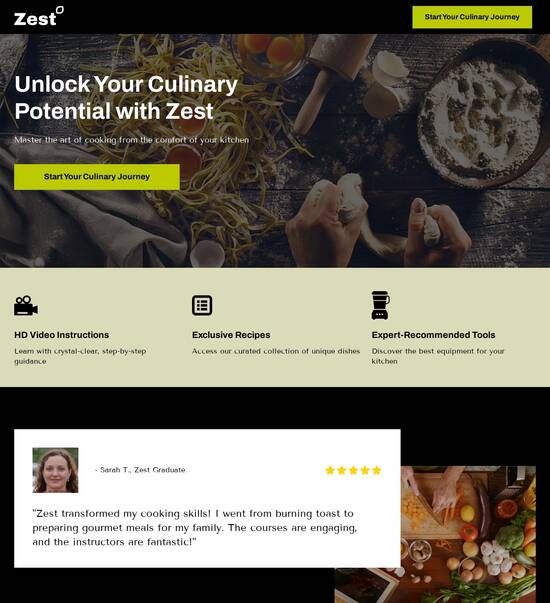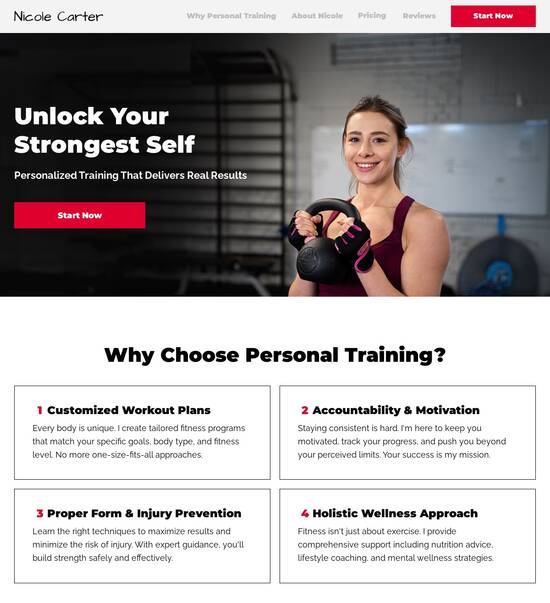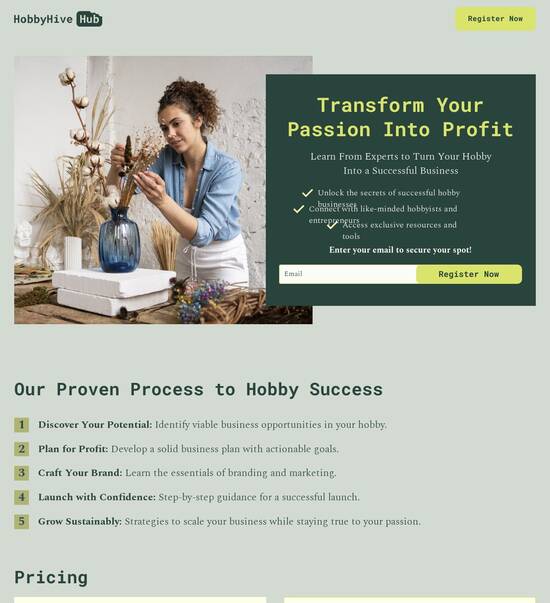
HTML page template for textile mills
Use TemplateAbout template
Engage your audience like never before with stunning landing page templates for textile mills. Make your online presence unforgettable!
Recommended templates

Easy to build without coding
With the intuitive drag-and-drop builder, anyone on your team can create high-converting pages without any knowledge of code or design. Make enhancements to your landing page with custom widgets using Javascript, HTML/CSS, or third-party scripts.

Multiple layouts for any industry and goal
Select from 500+ landing page layouts built to boost conversions across industry-specific scenarios. Customize them by adjusting fonts, adding images, and generating on-brand content with the AI assistant. Quickly scale with Instablocks® and Global Blocks that you can save, reuse, and update globally.

Loads fast and looks polished on any device
Every template is responsive, which means they present professionally on any device and load blazingly fast with our Thor Render Engine. You can also power them up with Google AMP technology to deliver an unparalleled mobile experience and drive higher conversions.

Robust analytics & experimentation
Get real-time updates and reporting across all your devices, showing the number of visitors, conversions, cost-per-visitor, and cost-per-lead. Launch AI-powered experiments, run A/B tests, and use heatmaps to analyze user behavior, then optimize your landing page to maximize conversions.







Easy to build without coding
With the intuitive drag-and-drop builder, anyone on your team can create high-converting pages without any knowledge of code or design. Make enhancements to your landing page with custom widgets using Javascript, HTML/CSS, or third-party scripts.
Multiple layouts for any industry and goal
Select from 500+ landing page layouts built to boost conversions across industry-specific scenarios. Customize them by adjusting fonts, adding images, and generating on-brand content with the AI assistant. Quickly scale with Instablocks® and Global Blocks that you can save, reuse, and update globally.
Loads fast and looks polished on any device
Every template is responsive, which means they present professionally on any device and load blazingly fast with our Thor Render Engine.
Robust analytics & experimentation
Get real-time updates and reporting across all your devices, showing the number of visitors, conversions, cost-per-visitor, and cost-per-lead. Launch AI-powered experiments, run A/B tests, and use heatmaps to analyze user behavior, then optimize your landing page to maximize conversions.
All the features you need to build textile industry website template free download
Explore more featuresLearn how to build fabric store website template
Frequently asked questions about textile website templates free download
Leading the way in building high-performing landing pages





Textile business template: Your ultimate how-to guide
Instapage is recognized as the leading landing page and conversion rate optimization (CRO) platform, particularly beneficial for marketers across diverse sectors including tech, education, and finance. Optimizing landing pages effectively is crucial for maximizing the return on investment of your digital marketing efforts. This guide will walk you through how to leverage Instapage's powerful features step by step.
Understanding the importance of landing pages
Landing pages are the focal point of your digital marketing campaigns. They convert visitors into leads and customers, hence their optimization is vital. A well-crafted landing page can significantly boost your conversion rates, ensuring that investment in your marketing efforts yields higher returns. Benefits include improved user engagement and increased lead generation when executed correctly.
- Enhanced targeting: Tailoring messages to specific audiences increases relevancy, thus improving conversion.
- Streamlined design: Using Instapage’s templates reduces friction, making the user experience seamless.
- Data-driven decisions: Instapage's optimization tools provide insights, enabling marketers to adjust strategies for maximum impact.
Step 1: Choose the right template
Selecting the appropriate template is the foundation of your landing page. Instapage offers over 100 templates designed for various industries, ensuring a fit for your unique needs. Factors to consider while choosing the template include your business type, target audience, and the specific campaign goals.
Step 2: Customize for your audience
Once you have selected a template, customizing it is crucial. This step involves tweaking text, images, and call-to-actions to resonate with your specific audience. Utilize dynamic text replacement and personalized content features to make the experience more engaging.
- Personalization tools: Use audience segmentation to serve tailored messages.
- Incorporate visuals: High-quality images related to your campaign can boost engagement.
- Consistent branding: Ensure colors, fonts, and messaging align with your brand identity.
Step 3: Optimize and Analyze
With your landing page set up, the next important step is to launch it while continuously monitoring its performance. Leverage Instapage’s built-in analytics and A/B testing features to evaluate the effectiveness of your page in real-time.
- A/B testing: Experiment with different headlines or images to find what works best.
- Heatmaps: Utilize heatmaps to see where users are clicking and adjust your layout accordingly.
- Feedback loops: Encourage user feedback to gain insights into their experiences.
In conclusion, a well-optimized landing page using Instapage fosters better user engagement and enhanced conversion rates. By choosing the right template, customizing for your audience, and continuously optimizing, your digital marketing campaigns can achieve unprecedented success.
Ready to take your marketing to the next level? Visit Instapage today and explore how our platform can help you craft high-converting landing pages tailored for your audience.
People also ask about industrial website template free download
HTML page template for textile mills
Understanding the unique needs of textile mills
The textile industry undergoes constant evolution, driven by changing fashion trends, consumer preferences, and technological advancements. Today’s textile manufacturers face several challenges, including increased competition, economic fluctuations, and the demand for sustainable practices. The importance of having a robust online presence cannot be overstated, as it helps textile mills showcase their products, reach a broader audience, and drive sales.
To create a successful HTML page template, textile mills must define their target audience. This includes fabric retailers, wholesale distributors, fashion designers, and other manufacturers. Each of these groups has unique needs and preferences, which must be considered during the template design process to ensure a tailored user experience.
Core components of an effective HTML page template
An effective HTML page template should prioritize user-friendly navigation, allowing visitors to easily find the information they seek. A suggested layout includes a clear menu, intuitive search functions, and a well-structured grid for product displays. Implementing engaging visuals, such as high-quality images and videos, can enhance the overall user experience and keep visitors exploring the site.
Essential elements of the template should feature branding specific to textile production, including a professional header and footer. Product showcases and detailed descriptions are critical for convincing potential buyers of the quality of the textiles on offer. This level of detail instills trust and encourages users to make purchases.
User-friendly navigation to enhance the browsing experience.
Professional header and footer designs aligned with textile branding.
High-quality product images and detailed descriptions to improve trust.
Moreover, CSS customization is pivotal for creating appealing aesthetics that resonate with textile themes. Designers can utilize specific color schemes and typography that reflect the vibrant nature of textiles while ensuring readability and engagement.
Key features of the textile mills HTML template
A vibrant, dynamic product catalog is fundamental to an effective HTML page template. This feature allows for interactive displays of a myriad of fabric options. Users should have the ability to filter products based on various qualities such as texture, color, and weight, facilitating a streamlined shopping experience.
Additionally, the template should include textile design showcasing tools. Users must be able to upload and display various textile designs on the webpage, highlighting the importance of high-quality imagery. Incorporating 360-degree views of products further enhances user engagement, allowing customers to explore fabric choices in detail.
Dynamic product catalogs for a wide range of fabric options.
Interactive filters based on texture, color, and weight.
High-quality imagery with 360-degree product views.
Finally, responsive design essentials are indispensable, ensuring the website is mobile-optimized. Implementing fluid grids and scalable images allows users to have an enjoyable experience on any device.
Innovative measurement tools for enhanced user experience
Integrating analytics tools into the HTML page template offers valuable insights into user behavior. By tracking metrics such as user engagement and sales conversions, textile mills can refine their web offerings to better meet customer needs. This data-driven approach is essential for understanding market trends and improving product visibility.
Incorporating feedback mechanisms, such as surveys and user feedback forms, allows businesses to gather insights on their offerings. Ensuring continuous improvement should be a priority, allowing for enhancements based on actual user experiences. Regular A/B testing of different page elements can further help eventually optimize the user interface.
Analytics integration for tracking user behavior.
Feedback mechanisms for continuous improvement.
Regular A/B testing to refine page elements.
Integrating AI and technology in textile web templates
The integration of AI-driven visualization tools can significantly enhance the user experience on textile mills' websites. Such features allow users to visualize fabric options in real-world scenarios, benefiting customers looking to make informed purchasing decisions. AI also aids in customizing designs based on individual customer preferences, improving engagement and potential sales.
In addition, incorporating automation for inventory management is crucial for efficiency. Integrating syncing tools that update product availability in real-time can streamline the buying process for customers. This ensures that users always have access to the latest information regarding fabric stock levels.
AI-driven visualization tools for fabric options.
Customization features based on customer preferences.
Automation tools for real-time inventory management.
Customization opportunities for designers
Designers have the opportunity to tailor HTML templates to various textile products, ensuring that the layout aligns with the specific needs of different fabric categories such as silk, cotton, and synthetics. Each category can be integrated with unique selling propositions that highlight the advantages and key characteristics of the individual fabrics.
Furthermore, employing advanced CSS techniques allows textile manufacturers to incorporate unique branding elements. Utilizing creative animations and transitions can create visually compelling experiences that keep users engaged and enhance brand identity.
Custom templates for different fabric types.
Unique selling propositions for various products.
Advanced CSS for creative animations and branding.
Ensuring quality and suitability in design
Establishing trust with potential buyers is crucial, and this begins with quality assurance indicators on product pages. Textile mills should highlight certifications and industry standards prominently within the design. Doing so reassures customers that they are making informed decisions when purchasing fabric.
High-quality content also plays a pivotal role in engaging users. Detailed descriptions and storytelling can evoke emotions surrounding the textile products, allowing customers to visualize their potential applications. This narrative aspect can further elevate the perceived value of the textiles.
Quality assurance indicators for consumer trust.
Highlighting certifications and industry standards.
Detailed descriptions and storytelling to enhance engagement.
Future-proofing textile mill websites
To stay relevant, textile mills must adapt to emerging trends in web design. This involves continuously updating HTML page templates to align with evolving market demands and technological advancements. For instance, the growing emphasis on sustainability and transparency could influence design choices and content strategies.
To ensure ongoing optimization, regular updates and maintenance of web templates are necessary. This commitment to improvement should also include leveraging customer feedback for future features and enhancements, ensuring that the website remains aligned with user needs and market trends.
Staying updated with design trends for relevance.
Regular updates and maintenance for templates.
Using customer feedback for continuous enhancement.
Case studies: successful implementations of HTML templates in textile mills
Examining successful case studies of leading textile manufacturers reveals valuable lessons. These mills have enhanced their web presence by focusing on key features such as effective user navigation and visually engaging product displays. The impact of these changes has been evident in their business metrics, reflecting increased engagement and sales.
Key takeaways from these implementations include the value of understanding user needs, the importance of high-quality visuals, and the necessity for responsive design. For textile manufacturers embarking on their digital journey, these lessons can provide essential guidance in building a successful online platform.
Leverage user navigation to enhance web presence.
Utilize high-quality visuals to increase engagement.
Ensure responsive design for optimal usability.
Conclusion: envisioning the future of textile mill web design
The landscape of textile e-commerce is rapidly evolving, placing a premium on innovative and robust web templates. As textile mills seek to enhance their online presence, a focus on creating engaging and user-centric templates is crucial. Commitment to ongoing innovation and the adoption of new technologies will empower textile manufacturers to remain competitive in this dynamic market.
In summary, implementing an effective HTML page template not only attracts potential customers but creates a memorable online experience that fosters brand loyalty and increases conversion rates. For textile mills, the journey towards a successful digital framework begins with understanding their unique needs and taking strategic steps towards creating an impactful online identity.
Ready to skyrocket conversions?
Supercharge your ad campaigns with high-performing landing pages
Get started














